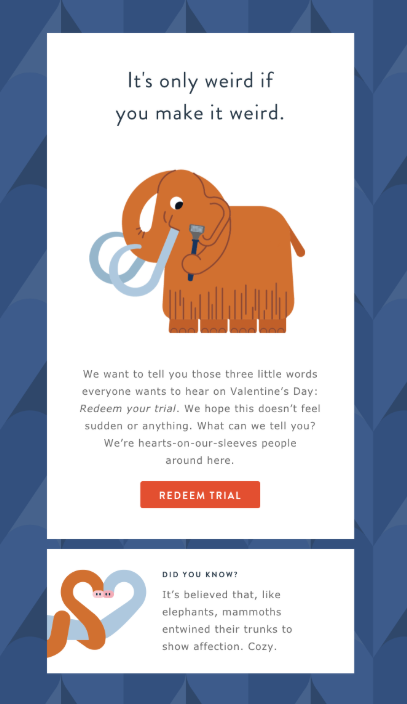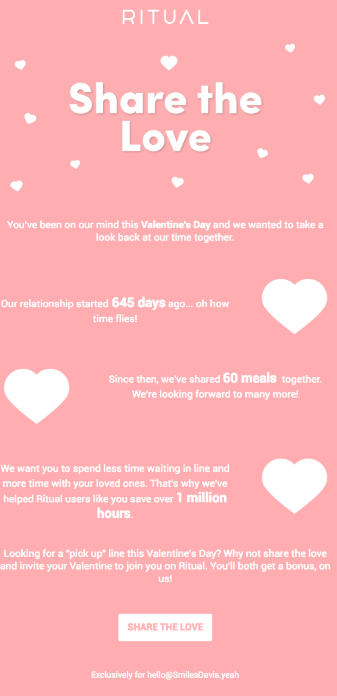

5 tips for sending Valentine's Day emails

It seems like only yesterday we were discussing Black Friday tactics and how to engage shoppers in the post-holiday season. But, as is always the case, the end of one holiday paves the way for the next. And the next is Valentine’s Day. We have five top tips to help you get ready for the next round of seasonal marketing emails.
Before you get started with your Valentine’s Day marketing, it’s important to remember one thing: not every email marketing campaign during this period needs to be about love and hearts and kisses.
Similarly, just because Valentine’s Day may not feel like a natural fit for your brand, doesn’t mean you can’t make the holiday work for you.
The key to effective seasonal marketing lies in your understanding of your customers. To be honest, this is an essential part of all omnichannel marketing. But when it comes to holiday marketing, knowledge of your audiences’ general age range, interests, and more can help you decide the appropriate path to take customers down.
You must remember that, while some people love Valentine’s Day, others don’t. Therefore, it’s important that you get the tone and message right. To help you do so, we’ve got five top tips to help you get started.
1. Make it part of your story
Your brand story is one of your most powerful marketing tools. It’s a big part of what makes your brand memorable, long after customers have left your website or social media channels.
To guarantee your Valentine-themed marketing lands with an impact it’s important to consider how it fits with your overall brand message. The sentimental and heartfelt theme of the holiday makes it a good time to reflect on your community and highlight your core brand values.

Indian fashion brand, Myntra use Valentine’s Day to spread its message of inclusivity. Through the power of brand storytelling, Myntra inspire customers to engage with its marketing and drive conversions without using words like ‘sale’ and ‘gifting’.
2. Timing is everything
Think very carefully about your target audience and when they’re likely to be buying Valentine’s Day gifts. If you sell big-ticket items, you need to be sending out your emails around now. People don’t often buy high price products on a whim. They like to take their time and consider the options.
This email from Apple perfectly showcases its range of products. The big ‘Valentine’s Day’ difference from its normal marketing emails, is its tone. Rather than convincing the reader about why they need a new phone, it’s shifting the focus onto the gift recipient.

Sent with plenty of time for shoppers to make their decision, Apple has got everything right with this email.
If you’re not sure when to send your Valentine’s Day email, it’s time to turn to your data. What campaign did you send last year? When did you send it? How often? What were the results?
Data is the most powerful weapon an email marketer has, so make sure you’re using it.
3. Kick-off mid-month sending
Holidays are a great opportunity to kick off mid-month campaigns. Typically, we don’t like starting new campaigns in the middle of the month as it’s harder to measure the results without fear of them being skewed by previous activity.
During a holiday period such as Valentine’s Day, subscribers’ inboxes are overwhelmed with brands trying to sell their goods under the guise of holiday gifts. Starting a campaign at this time could benefit you in two ways:
- Customers are looking for something special in their inbox and your new campaign could be exactly what they’re looking for.
- Customers are bored of receiving the same old sale emails, and your new campaign will capture the readers’ attention.
But, in order to achieve this, you need to embrace the holiday and make it a part of your message. As with Apple, Roadshow Films have got the tone spot-on for this email. Rather than change its message about an upcoming release, it has simply put a ‘Valentine’s Day’ spin on it.

4. Be creative to cut through the noise
Inboxes are overloaded at the best of times, and the situation is worsened during holidays. To really create an impact with your seasonal marketing, it’s important to think outside of the box. That’s made even more important if your brand doesn’t naturally fit in with the ‘Valentine’s Day’ theme.
Creative thinking can be hard, especially if writing copy is only a small part of your role in the marketing team. But, if you can successfully add a romantic spin to your email during this seasonal period, you’re going to be capturing readers’ attention and helping to create a stronger relationship with them.


We really like these emails sent by Harry’s Shave Club and Factory Authorized Outlet. While they’re not the typical brands you would associate with Valentine-themed messages, their tongue-in-cheek approach really resonates with the reader.
5. Personalize the message
To be honest, this is a tip that works, no matter the seasonal campaign you’re working on. Customers like personalization. It helps them feel as though they’re more than just another faceless shopper to a brand.
The more you personalize, the deeper the connection they’ll have with your brand. Therefore, tapping into your data is key.

The food ordering service, Ritual, employs two key pieces of customer data in this email: days since sign-up, and the number of meals ordered. It’s only two insights, but the result is a much more personal connection with the reader than simply using the readers’ first name.
Bonus tip: test, test, test
Similarly, as with our top tip to personalize, testing is essential far beyond your seasonal marketing campaign. Subject lines, in particular, are going to play a key role in your Valentine’s Day campaigns. In busy inboxes, your subject line is going to be the main driving force encouraging shoppers to open your email.
Split testing is the only way to optimize this part of your campaign. It’ll also offer a bank of data to help you when planning your activities for the next year.
Contents
Jenna Paton, Content Marketing Manager
Jenna expertly writes thought-leadership content about cross-channel marketing and customer engagement and manages the creation and execution of Dotdigital's content marketing strategy.
Stay on top
Get the latest and greatest marketing insight delivered to you weekly
Your email address will be handled in accordance with our Privacy Policy. We gather data around email opens & clicks using standard technologies including clear gifs to help us monitor and improve our newsletter.

